If you want to listen to the Hi-Res files in the authentic quality and test the capability of your headphones or a speaker set, hookup the best DAC amp combo. This device will take little place on your desktop or belt, but it will change the way your acoustic gear produces the sound.
Want to find out how to get the DAC and amplifier device you need? Read the article below, it reveals the primary and secondary features of the amp / DAC gear, current offers, and gives a clue to the image of the most appropriate amp / DAC for different purposes and setups.
DAC Amp Combo Reviews
AudioQuest Dragonfly — Best Headphone Amp DAC Combo
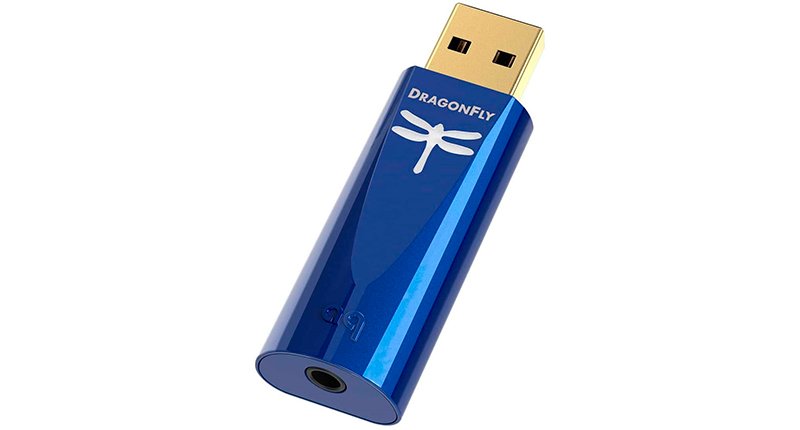
For those who like to listen to high-quality music on the go, this small device might become the best headphone amp DAC. It’s compact and easy-to-use, improves your sound considerably with regard to the direct PC / smartphone playback, and looks good, too. The compact design, however, doesn’t leave room for controls — there are none onboard.
The size of this model is 0.74 x 0.47 x 2.24 inches, its weight is 4.2oz. It has a USB Type-A connector and is supplied with the Type-C adaptor. The adaptor is short and sturdy and doesn’t bring in jitter or noise. On another end, the unit has a standard 3.5mm jack for headphones.
The DAC part of this model works well with almost any type of sound file. It can process them with up to 24/96 kHz resolution and amplifies well. I enjoyed the improved MP3 performance with a more accurate main line, cleaner bass and highs. Still, when it came to MQA and ALAC, the difference was yet more obvious. There’s plenty of detail, and the integrated slow roll-off and minimum phase filters make audio neutral, without an accent on any particular frequency range.
This DAC amp combo is equipped with 64-bit volume control offering a sensitive detailed response. The sound gets loud without distortion up to high levels.
Pros
- Advanced Microchip provides for a small current draw and 2.1V output.
- Compatible with Windows, Android, iOS, Linux devices.
- The Dragonfly insert changes color with regard to the frequency played and the status of work.
Cons
- Connected to iPhone, the headphones controls and mic don’t work.
- Sounds a bit tight in the highs.
Video AudioQuest Dragonfly
FiiO E10K — Best DAC Amp Combo under $100
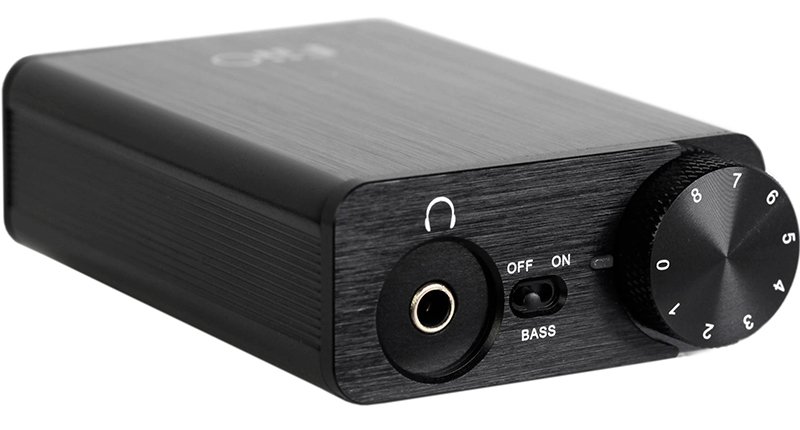
This inexpensive portable combo unit offers a variety of controls and inputs, and works with Hi-Res files at 24/96 kHz resolution. It certainly deserves a place on your best DAC amp under 100 list for its advanced design and considerable output. The only caution I’d put is that the unit provides a warm sound; so, if you need the “dry” studio-quality audio, it mightn’t fit.
The DAC amp is compact and has a smooth finish, rounded corners without sharp edges. The casing is made of aluminum accounting for a small weight (just 2.72oz). The device would fit in half of your palm being 3.11 x 1.93 x 0.83 inches big.
The power output of this amp makes 10W, and it’s compatible with headphones ranging from 16 to 150 Ohms. The amplifier and DAC are powered by different chips making the output clear and solid. The frequency range makes 20 Hz – 20 kHz, and the unit draws a detailed soundstage with the distinct ranges. There are also several technologies implemented to boost the low-end of your audio: the low-pass filter, bass boost technology bring the powerful and non-muffled bass played from any device.
The Fiio e10K setup is simple. Plug in your headphones into the front 3.5mm jack, connect the source via the micro USB, select the volume and desirable bass level, and you’re good to go. There’s also a coaxial output and Line Out jack, letting you connect the active speakers as well.
Pros
- The sensitivity of 108 dB allows you to increase the volume without losing sound clarity.
- The USB port works for power as well.
- The volume knob has a blue LED light, which is convenient to use in the dark.
Cons
- Sounds a bit flat on complex music like R&B or Acid Rock.
- The supplied micro USB cable is short and isn’t convenient to use with the PC.
Video FiiO E10K
Sound Blaster G6 — Best DAC Amp Combo under $200
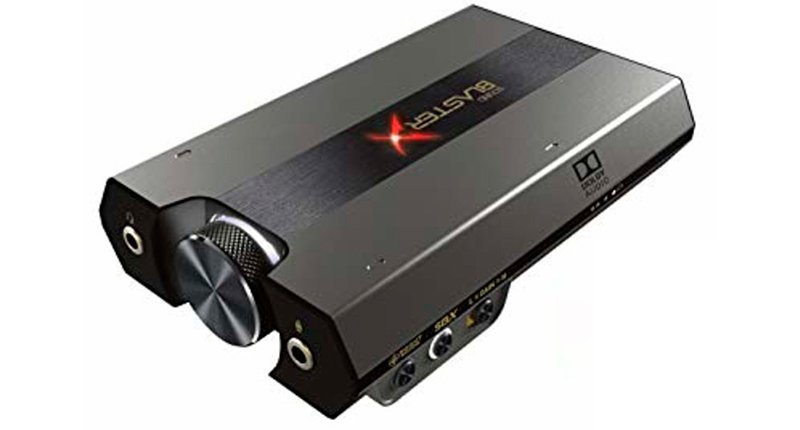
Built on the basis of the USB sound card, the G6 model integrates the high-resolution DAC (32-bit and 384 kHz frequency) and a powerful low-impedance (1-Ohm) amplifier. With the high sensitivity of 130 dB, it probably makes the best DAC amp combo for gamers. However, when using the DAC at the highest sampling speed, it might occasionally provide clicks and hisses before the audio playback.
The amp DAC is designed primarily for gaming, and as such it has separate inputs for headphones and the mic. The amplifier can drive the headphones and headsets from 16 to 600 Ohms providing a lot of detail and balance to the audio output. The voices and effects sound distinct, and the smart processor filters the background sounds giving preference to the voices (the Scout mode). The unit is compatible with gaming consoles, as well as with a variety of AV sources.
The box isn’t the smallest, it’s 4.37-inch long, 2.76-inch wide, and 0.94-inch tall. It weighs 7.1oz and has 2 inputs (headphones and mic) on the front, with the volume dial in between. On the back panel, there is a ⅛-inch Line In port and ⅛-inch Line out, and the micro USB with bus-powered functionality.
The audio formats supported include Dolby Digital and 5.1- and 7.1-surround sound formats providing the immersive soundstage with high-class separation. This makes this USB DAC amp suitable for gaming, movie watching, and music listening.
Pros
- The amplifier works in the bi-amp mode amplifying each headphone channel separately for high clarity.
- Sidetone control lets you regulate the level of hearing your own voice.
- Dynamic and clean playback of PCM files.
Cons
- The LED light around the volume dial cannot be turned off.
- Gets hot after a few hours of use.
Video Sound Blaster G6
EarStudio ES100
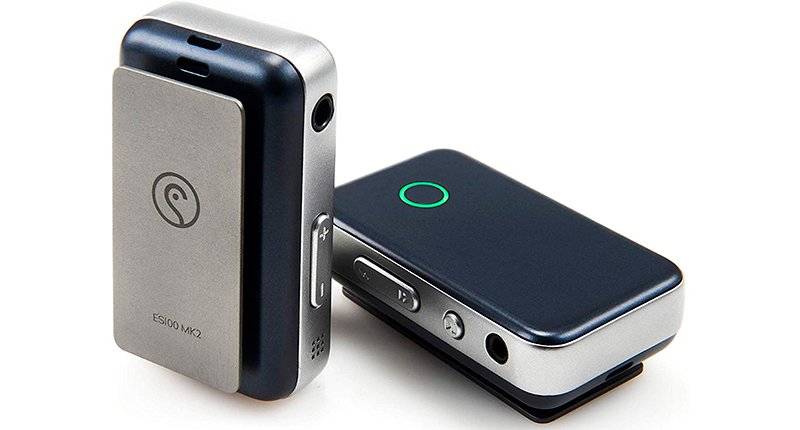
If you need the best portable DAC amp, look at the specs and performance of the ES100 model from EarStudio. This compact device is only 2-inch long, 1-inch wide, and 0.5-inch tall and weighs less than an ounce. Meanwhile, it includes an amp providing from 1.1 Vp to 2.2 Vp output at 16 Ohms, a DAC with a high sampling rate (24/192 kHz), a balanced and unbalanced input, and a bus-powered USB. However, the main advantage of this model is Bluetooth.
The Bluetooth version installed in this DAC amp is 5.0, and it features several high-capacity codecs including the LDAC and aptX. The files are reproduced immediately, and the precision of the instrument separation is immediately heard. The audio output is well-balanced and features rich and airy highs, and clear mids and lows. It’s cleared from the outside noise and jitter and amplified through the Dual Drive amp powering each channel with a separate amp block.
The impedance of the amp is small making 0.5 – 1.0 ohm and letting you connect any pair of headphones to it. The DAC amp combo unit has the developed smartphone compatibility letting you control the playback, perform the EQ, regulate the volume (e.g. setting the maximum level), controlling the filters, and customizing the settings via the remote control app.
Pros
- Works over 10 hours on a single battery charge.
- Includes Slow and Sharp roll-off filters with the Short delay option.
- The backside clip is handy for attaching the device to the belt, pocket, or other objects.
Cons
- The control buttons on the unit are small and not too handy.
- Plastic build, a bit cheap look and feel.
Video EarStudio ES100
FiiO Q1
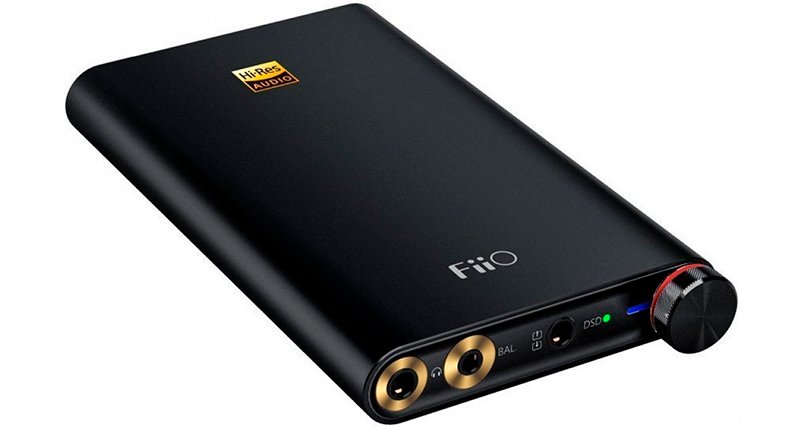
The expensive-looking design and sturdy build, a high sampling rate of 384 kHz and 32-bit make this model stand out among the DAC headphone amps. The box is small at 3.9 x 2.32 x 0.47 inches and weighs just a bit less than 4oz. It’s equipped with both balanced and unbalanced headphone jacks and a micro USB. When connected via the USB port, the device can also work as a DAC playing the files at a high bit rate.
The playback of the lossless audio through this DAC amp provides a highly detailed soundstage with a discrete “picture” of each instrument and voice. The audio is powerful and clear, with a neutral sound signature. The DSD files are played at 256 kHz frequency, and the PCM ones — at 384 kHz. This is enabled with the premium Xmos hardware discerning the formats and selecting the appropriate mode of playback. The unit also indicates when a DSD file is played, by turning on the green LED light on the front panel.
The device is equipped with a low-pass filter making the bass sound clean and solid. There are the “gain” and “bass boost” sliders on the back panel of the box letting you customize the levels to your liking.
The combo unit works with Windows through the drivers’ installation, but it’s specifically aimed at iOS compatibility. It works in a plug-n-play mode with MacBook and iPhone, has the Lightning cable supplied, and boasts the Apple certification level. If you own an iOS device, it might be the best DAC/amp for you.
Pros
- Automatically detects the input in use and adjusts the settings accordingly.
- Long battery life: about 10 hours via the USB, 20 hours via the mini-jack.
- Metallic body with curved lines; fits well with the supplied rubber rings (holder).
Cons
- The volume knob protrudes a bit too much; not handy to use when the amp is laid on some surface.
- No Android support.
Video FiiO Q1
iFi Zen — Best Desktop DAC Amp Combo
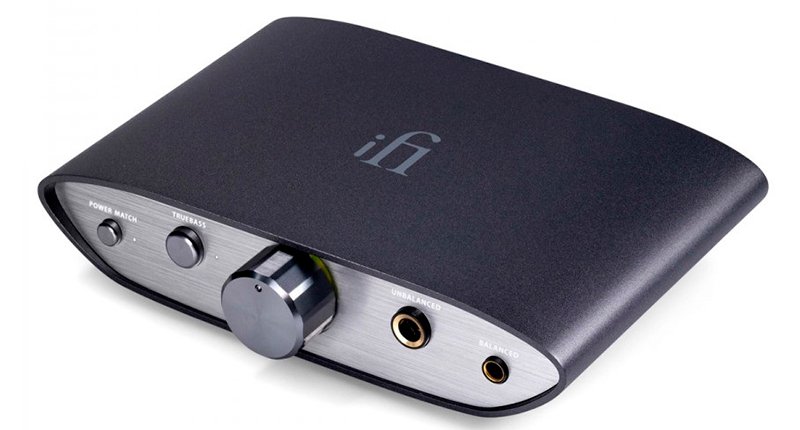
Multiple inputs on this device let you connect almost any type of headphones and speakers, as well as different sources. The unit has 2 balanced inputs of 4.4mm, a single unbalanced jack of 6.3mm, dual RCA ports for speakers, a USB Type-B for connecting to the PC or smartphone, and a power port (5V DC). If you plan on using several output systems, this might be the best amp DAC for the purpose. It’s a bit bulky though, at 1.8lbs and 4.6 x 3.93 x 1.18 inches of dimensions.
The USB port is 3.0 version, with backward compatibility to 2.0 one. It can transmit Hi-Res files without losses and lag. Supported with the discrete circuitry and high-class Burr-Brown DAC, it can play the MQA files directly without decoding, preserving the detail and sound signature in full. The DXD format can be played at 384 kHz frequency, the DSD at 256 kHz and the PCM to 24-bit at 384 kHz.
The device supports the precisely drawn frequencies on all ranges, with the exact mids and open highs. For more bass, the “true bass” mode can be selected by pushing the relevant button. The bass is deep, with a well-shaped bottom and a lot of power.
The volume control can be set as variable or fixed, letting you customize your setup and connect to a preamp while bypassing the volume control. The onboard regulator is analog, with a sensitive yet not loose knob. This desktop DAC amp is powerful providing from 1V to 6.2V output depending on the connection and features a high SNR of 116 dB.
Pros
- Fast and detailed playback of music from the streaming services (Deezer, Amazon Music, Spotify, etc.).
- PowerMatch function lets you customize the amp to power the headphones in an optimal way.
- Class 1 ceramic capacitors produce clean noise-free sound.
Cons
- Doesn’t have a power switch.
- A 5V power supply cable isn’t included.
Video iFi Zen
FiiO K5 Pro
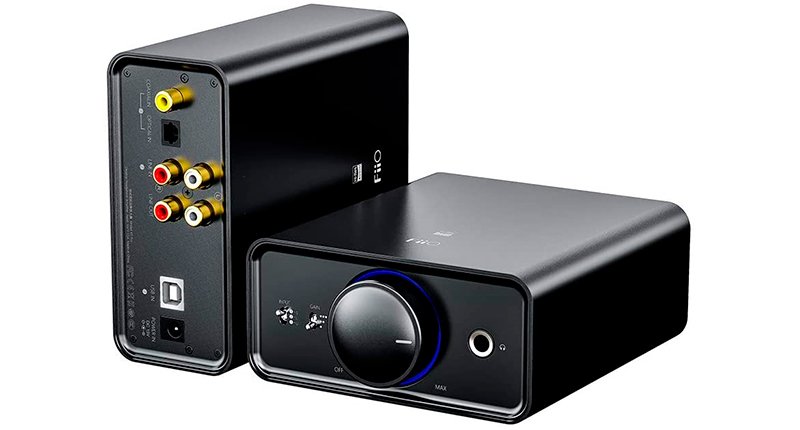
If you’re looking for the DAC and amp that would be rock solid, versatile, and simple to use, the K5 Pro could be the best DAC/amp combo. Though its design (it weighs a bit less than 1lb and has the dimensions of 4.74 x 5.11 x 2.17 inches) doesn’t prove to be well portable, it serves multiple purposes as a stationary amp and DAC. It can power almost any type of headphones, active speakers, and mobile devices like an MP3 player, etc. The device has an aluminum textured design and a smooth finish that support the notion of a premium model as well.
The DAC/amp has a developed audio and amplification circuit, with the filtered DC supply and the secondary amplification of the inner circuits. It integrates the low-pass filter, the analog volume regulation, the voltage increase, and the current drive. All the components and joints are performed in a way to minimize crosstalks and current draws. This results in distortion-free clear audio with each instrument and voice reproduced naturally and in full. Such construction lets the DAC reproduce the Hi-Res sound at 512 kHz (DSD) and even 768 kHz, with a 32-bit rate.
The connections include two pairs of RCA ports (inputs and outputs), the coaxial and optical port, the USB Type-B, the 6.35mm headphone jack, and the DC power supply (15V). The DAC amplifier drives easily the headphones with 32-Ohm and up to 300-Ohm impedance, with the output up to 1.5W.
Pros
- A highly sensitive volume regulation chip and circuit let you adjust the gain by 0.5 dB.
- The LED backlight changes with regard to the sampling rate/frequency applied.
- Sturdy gold-plated connections for headphones, RCA, and coaxial ports.
Cons
- The playback through the RCA features less resolution than via headphones jack.
- No USB-powered port.
Video FiiO K5 Pro
FiiO BTR5-384K
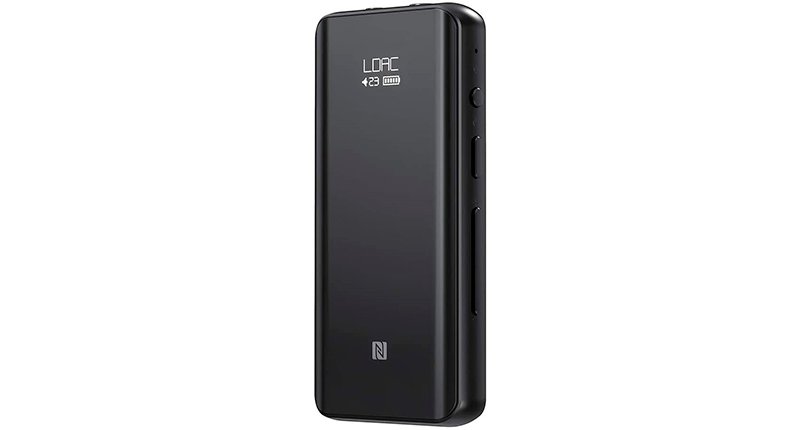
The minimalist design of this Bluetooth DAC amp conceals various options and functions it provides. It has advanced chip construction and a solid amplifier. The device can reproduce audio in the native 32-bit resolution and does it without a physical connection. Its size is 2.83 x 1.26 x 0.43 inches and its weight is 1.54oz, and developed wireless connectivity provides it high portability as well.
The Bluetooth version is 5.0, and the formats supported include aptX HD and LDAC, along with many others. It lets you playback files in high resolution (up to 96 kHz) via the streaming apps or directly from the Bluetooth-enabled device. To pair the devices, you can use the NFC functionality and just tap the BTR5-384K against a smartphone or a tablet to get a stable BT connection.
The physical connections include balanced and unbalanced inputs. The balanced port is connected to 2 DAC units and can provide up to 220 mW output at 32-Ohm impedance. The inner circuitry utilizes the FPGA clock management functionality cutting the signal noise and producing the steady authentic audio output. The USB connection is Type-C one with the bus-powered option. When connected via USB, the DAC / amp can process DSD files at the native 384 kHz rate.
The OLED screen with various information about the input, sound format, volume, battery, and call status is another thing making the BTR5-384K a candidate for the best amp DAC combo. The display also shows the menu and lets you adjust the device settings.
Pros
- Dual volume regulator type (digital and analog) brings a sensitive volume control while keeping the amplified signal clear.
- It has a built-in mic and is compatible with the CTIA-enabled headsets.
- In “Car” mode, it automatically turns on and off along with the car.
Cons
- The EQ function doesn’t work when transmission via LDAC is engaged.
- The volume change is rather slow (takes pressing a button several times or holding it).
Fosi Audio Q4
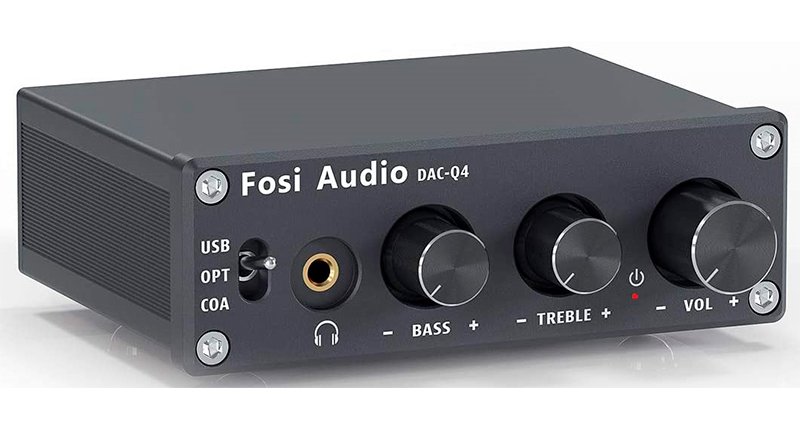
Need a device that will work as a preamp, DAC, has comprehensive controls, various connection options, and wouldn’t break the bank? The Fosi Audio Q4 can well be called the best budget DAC amp on the list. Save for the lack of wireless connection, it has everything an average home setup might need and provides a high-quality audio output at 24 / 192 kHz.
The amp on this device boosts the audio well powering the headphones from 16- to 200-Ohm impedance. The regular power output makes 160 mW. The headphone jack is an unbalanced 3.5mm one. Other ports include coaxial, optical, and USB Type-B and C jacks, and 2 RCA outputs that can connect to the active speakers. On the back panel, there’s also a 5V USB input serving for power only. The maximum sampling rate for the USB transmission makes 24-bit / 96 kHz.
The dimensions of this amp/DAC combo are 2.89 x 3.86 x 1.30 inches, it weighs a bit over 1lb. The body is aluminum with a simple smooth finish and good heat dissipation. The controls are sturdy and include a volume knob, bass and treble regulators, a toggle switch for input selection.
The sound produced by this amp/DAC is clear, with sharp mids and decent lows and highs. The output is dynamic, and the volume sensitivity is quite high.
Pros
- The inner output signal path is protected from jitter and environment noise.
- Doesn’t require the driver installation, works right away upon connection being established.
- Let equalize the active speakers and get the desired sound output.
Cons
- No Dolby / DTS formats support.
- The input switch is a bit stiff and not easy to handle.
Video Fosi Audio Q4
FX-Audio X6
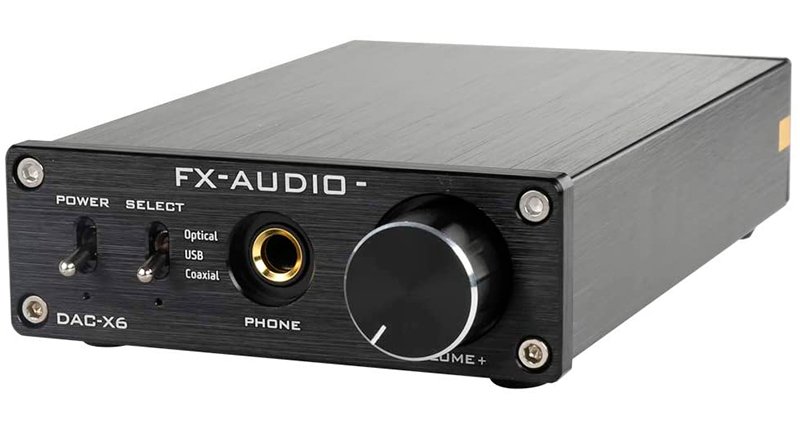
The outstanding feature of this DAC and amp combo is its ability for being upgraded. The amplifier blocks within it can be upgraded for the more powerful one or replaced with the equally potent units. The output of this amp makes 520 mW for headphones (it can power up the models from 32- to 600-Ohm impedance), and 1.8V for Line out connection.
The front panel holds a sturdy gold-plated stereo headphones output of 6.3mm size. The FX-Audio DAC-Xs can be hooked up to the PC via USB Type-B, DVD, or CD player, TV box via the optical or coaxial cable. There are also 2 RCA outputs and the 12V DC power plug. The power schemes are made discrete in order to ensure the low-noise signal path and protect the speakers and headphones connected with the separate relays.
The DAC/amp combo can process the sound signal up to a 24-bit rate and 192 kHz frequency. Besides, it can pass through the signal in Dolby Digital formats, including Atmos. The sensitivity level makes 94 dB. The device can make the headphones sound very loud, and there’s no obvious judder or muffling up to a high (70) level.
The box is made of metal and assembled well. The finish is smooth. The DAC/amp isn’t small, it weighs 1.1lb and is 5.7-inch long, 3.9-inch wide, and 1.4-inch tall. The knobs and toggle switches are also thick and responsive while not being loose.
Pros
- Toggle switches turn the DAC / amp on and off, select the input.
- Variable AC supply: 100 – 240V.
- Sturdy rubber feet keep the unit steady on the desk /another surface.
Cons
- All the outputs are powered at the same time.
- The LED light on the AC adaptor is too bright; the cord is rather short (about 3.6ft).
Video FX-Audio X6
Buyer’s Guide
Do you need a dac amp combo?
A DAC amp is an external device that combines two pieces of acoustic gear: the digital-to-analog converter and the amplifier. The same devices, but of a smaller size and quality, are integrated into all electronic devices dealing with digital signals and their output to speakers and headphones. They transform the digital signal to analog and then amplify it so that it could be received and reproduced by the acoustic drivers.
So, why would you need an external combo device? There are the following reasons:
- Better sound quality. The external DAC/amp usually packs much more power and the more developed DAC chips. This results in a more detailed and natural sound output. Still, any part of the chain “initial sound – listener” might let you down. In case you have a bad recording, a weak source, or low-quality headphones, the amp/DAC alone won’t help much.
- More control over your sound. Many DAC/amp combined units provide a more detailed volume control, low-pass filter, minimum phase, slow/ sharp roll-off, and other filters. The EQ functionality might be also integrated
- An input from / output to different devices. Many combo devices of the amp/DAC let you plug in the different headphones jacks and RCA ports. Meanwhile, you might also need a device that can connect to a TV, a CD player, a PC, and provide improved audio playback from these sources.
Features You Need to Consider Choosing a DAC Amp Combo
Inputs
For the majority of the everyday tasks, you might do well with a single USB input on your DAC/amp. However, if you plan on upgrading the sound from/on the different devices, it’s wise to take an amp/DAC with several inputs. The most frequent ones installed in the amp/DAC combo devices are headphones jack (3.5mm, 6.3mm), dual RCA ports, USB, coaxial and optical connectors. Some also support Bluetooth connection.
Sampling Rate
The sampling rate is important, as it shows the number of times per second that the device scans (gets samples) from the digital signal. For example, the 192 kHz rate means the DAC/amp gets a sample 192,000 times per second. Some of the devices can reach a 768 kHz sampling rate. The received data is transformed into an analog signal. The higher the number, the more accurate, rich, and jitter-free the analog output will be
Impedance
With regard to the acoustic gear, the impedance means the amount of power this device needs to work properly (e.g. 6 Ohms, 32 Ohms, 200 Ohms for headphones). This number also shows how much power it would take to disrupt such a signal. The devices with the higher impedance are considered more demanding, yet safer as well. The higher the impedance of the headphones, the less is the risk of overloading the other components of the setup.
Compatibility
Compatibility is important, as it means you can use the DAC/amp device with different types of gear. List the devices you are going to hook up to the combo device. These can be a PC, a smartphone, a DVD player, and so on. Then, examine the connectivity, technical parameters, software compatibility. It might turn out that the amp / DAC doesn’t work with a certain device (i.e. a tape player) or doesn’t support certain OS versions (e.g. Windows XP).
Portability
Many of the modern DAC/amp combined devices are quite compact (some are no more than 4 inches in length) and lightweight (less than 1lb). That makes them well portable. Another parameter affecting the portability is the number of cords necessary for the amp/DAC to work. Some models integrate a battery that can recharge via the USB connection or through the power plug. Some also support Bluetooth.

Hi everyone! I’m Thomas Moody, also known as Guitarzan.
